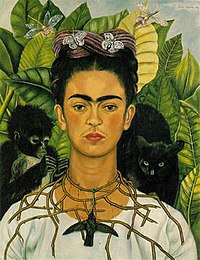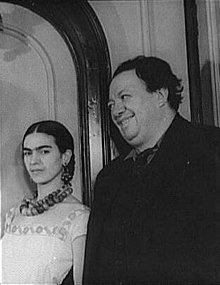Frida Kahlo: Difference between revisions
m Reverted edits by 132.177.60.154 (talk) to last version by 70.100.53.173 |
|||
| Line 27: | Line 27: | ||
===Character=== |
===Character=== |
||
Despite her life of suffering and pain, Frida Kahlo was a vibrant, extroverted character whose everyday speech was filled with [[Profanity|profanities]]. She had been a [[tomboy]] in her youth and carried her fervor throughout her life. She was a heavy smoker, drank [[liquor]] (especially tequila) in excess, was [[promiscuous]] and openly [[bisexual]], sang off-color songs, and told equally [[ribald]] jokes to the guests of the wild parties that she hosted. She enjoyed piano recitals. Her most notable bisexual affair was with singer [[Josephine Baker]]. [[http://gayinfo.tripod.com/A-Z-B. |
Despite her life of suffering and pain, Frida Kahlo was a vibrant, extroverted character whose everyday speech was filled with [[Profanity|profanities]]. She had been a [[tomboy]] in her youth and carried her fervor throughout her life. She was a heavy smoker, drank [[liquor]] (especially tequila) in excess, was [[promiscuous]] and openly [[bisexual]], sang off-color songs, and told equally [[ribald]] jokes to the guests of the wild parties that she hosted. She enjoyed piano recitals. Her most notable bisexual affair was with singer [[Josephine Baker]]. [[http://gayinfo.tripod.com/A-Z-B.htmle ]] |
||
she has pictures that she is doing thing naked because she wanted to have sex to have a baby |
|||
==Related Kahlo Web Site== |
==Related Kahlo Web Site== |
||
Revision as of 20:45, 26 September 2006

Frida Kahlo (July 61907 – July 13, 1954) was a Mexican painter of the indigenous culture of her country in a style combining Realism, Symbolism and Surrealism, an active communist supporter, and wife of the Mexican muralist and cubist painter Diego Rivera.
Kahlo was noted for her unconventional appearance, declining to remove her facial hair (she had a small mustache and unibrow which she exaggerated in self portraits), and for her flamboyantly styled clothing, drawn largely from traditional Mexican dress.
Background
Her parents were Guillermo Kahlo, a German immigrant, and Matilde Calderón, a Mexican native. Her mother was a very devout Catholic and frowned upon the wild games she and her best friend and younger sister Cristina played. She was much closer to her father, Guillermo, who was a photographer. The young Frida suffered a bout of polio at age six, which left her right leg looking much thinner than the other. Still, with her father's encouragement and with the feisty and brash personality that she kept throughout her life, she overcame her disability. Guillermo encouraged her to participate in boxing and other "manly" sports. Throughout her entire life, however, Frida was self-conscious of the aftermath of her battle with polio - specifically, the disease left her right leg shorter than her left. She wore long skirts to disguise this.
Frida was heavily influenced by the Mexican revolution, which began in 1910 when she was just three. In her writings she recalled that her mother would usher her and her sisters inside as gunfire could be heard in her hometown. Men would leap over the walls into her backyard, and some days her mother would prepare a meal for the starving revolutionaries. In fact, Frida went as far as to claim that she was born in 1910 so that people would associate her directly with the revolution.
She attended an arts academy during her educational years. She joined a gang and fell passionately in love with the leader; her first real love affair, but certainly not her last.
In 1925, a trolley car collided with a bus in which Kahlo was riding with her gang leader lover; she suffered a broken spinal column, a broken collarbone, broken ribs, a broken pelvis, 11 fractures in her right leg, a crushed and dislocated right foot, and a dislocated shoulder. She survived her injuries and eventually regained her ability to walk, but she would have relapses of extreme pain which would plague her for life, often leaving her hospitalized and/or in bed for months at a time, agonized and miserable. Frida would undergo as many as thirty-five operations in her life as a result of the accident, mainly on her back and her right leg/foot.
Much of her artwork is a reflection on the life she led and the suffering she endured.
Career as painter

After the accident, Kahlo turned her attention from a medical career to a full-time nursing career. Drawing on her personal experiences (her troubled marriage, her painful miscarriages, her numerous operations), her works are often shocking in their stark portrayal of pain. Fifty-five of her 143 paintings are self-portraits, often incorporating symbolic portrayal of her physical and psychological wounds. She was deeply influenced by indigenous Mexican culture, which surfaced in her paintings' bright colors, dramatic symbolism, and unapologetic rendering of often harsh and gory content.
Perhaps the most influential person in Frida's life was Mexican muralist Diego Rivera. They met when Rivera was painting a mural on the walls of her school. Frida demanded that he come down off the scaffold to see her paintings; to tell her if she was any good. Diego decided that this fiesty young woman had something. She had a gift. Frida spent the rest of her life obsessing over Diego, despite the fact that he was "not fit for monogamy" (this said by his doctor) and had affairs with countless women - including her own sister, Cristina (Diego was depressed from a failed tour of the U.S., and Cristina had taken her children and left her turbulent marriage, leaving her distressed). While Frida always forgave Diego, she went through much pain and suffering both when they were married and even during their period of separation; Frida once said "I have suffered two accidents in my life. One was when a streetcar ran over me... the other is Diego".
Although Kahlo's work is sometimes classified as surrealist, and she did exhibit several times with European surrealists, she never considered herself a surrealist. "I paint my own reality," she once said. Her preoccupation with female themes and the figurative candor with which she expressed them made her something of a feminist cult figure in the last decades of the 20th century.
Character
Despite her life of suffering and pain, Frida Kahlo was a vibrant, extroverted character whose everyday speech was filled with profanities. She had been a tomboy in her youth and carried her fervor throughout her life. She was a heavy smoker, drank liquor (especially tequila) in excess, was promiscuous and openly bisexual, sang off-color songs, and told equally ribald jokes to the guests of the wild parties that she hosted. She enjoyed piano recitals. Her most notable bisexual affair was with singer Josephine Baker. [[1]] she has pictures that she is doing thing naked because she wanted to have sex to have a baby
Related Kahlo Web Site
For a complete bio, photos, paintings, chronology, books and films visit:
External links
- "The Frida Kahlo Museum", by Gale Randall
- Exhibition guide from Tate Modern
- "Frida Kahlo & contemporary thought"
- "Frida by Kahlo"
- "Frida Kahlo" at ArtCyclopedia
- Frida (2002 film) at IMDb
- Template:Es icon "Dolor y arte: Frida Kahlo" from Psikeba Magazine
- Ten Dreams Galleries
- Photos
- Self-Portrait with Cropped Hair in the MoMA Online Collection
